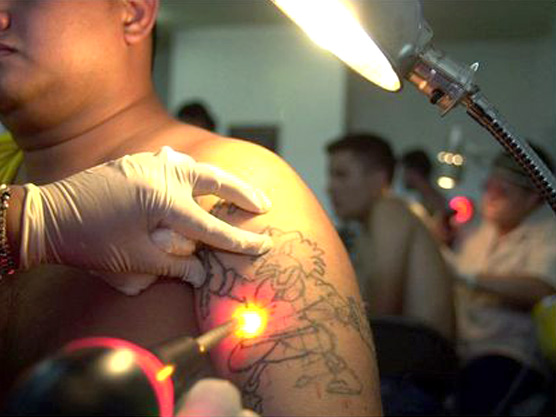
A young woman walks into Monarch Laser in Hayward to get several tattoos removed. She’s planning to start a career as an esthetician and knows that she needs to remove the tattoos on her hands in order to work in such a field.
“That makes it difficult – she needs to clean that up”, says Fran Mincey, of the career challenge the young woman will have with visible tattoos. As
president of Monarch Laser, Fran sees many people with different needs to remove tattoos.“People are trying to get back into the mainstream,” says Fran. “They need to get those remnants of the past removed.”
Besides career goals, the same young woman planning to work as an esthetician also represents the other main reason people want tattoos removed; they have left the gang life. In addition to the tattoos on her hands, she has a large gang tattoo on her upper chest – a tattoo that identifies her with a gang that she has left in her past.
Fran says she asked the woman why she got the tattoo and she replied, “I wasn’t thinking back then – I didn’t know how it was going to impact my life.”
Fran urges people to think about how a tattoo can affect their life before they get one. “It may be inexpensive to get a tattoo on, but it’s a very costly, timely and painful process to remove,” she asserts.
Though the cost for removal depends on the size and location of the tattoo, a small tattoo could cost $300 to remove. Most tattoos require between five and ten treatments spread over many months, sometimes as long as a year.
People don’t always have the ability to pay for removal of their tattoos. “They’re looking for resources, non-profits organizations or churches,” says Fran. “Some have family members who are willing to help them.”
Another group of people wanting to get their tattoos removed are people who have worked alone or remotely and are looking to work in an office environment where visible tattoos will make it more difficult to get a job or advance in the workplace. In many careers or industries, especially the healthcare industry, it’s necessary to have tattoos removed, especially the more visible tattoos on the neck or hands.
Joining the mainstream of society is especially challenging for ex-convicts. The non-profit organization Social Advocates uses Monarch’s laser machines to remove prisoners’ tattoos before their release from prison. Once a month, the organization, with the assistance of Monarch’s nurses, treat about forty prisoners. The main part of Monarch’s business is providing the laser machines and nurses to doctors and hospitals that offer tattoo removal and other laser therapy services such as hair reduction and treating acne scars and sun damaged skin. Laser technology is also used to treat children with deformed features or growths on their faces.
Fran says that laser therapy is very effective in removing brown spots on the face, which is fairly common with Hispanics. She wishes that more people in the Latino community knew that laser is an option for many skin conditions as well as tattoo removal.
Speaking again about the impact that tattoos can have on people of any age, she concludes by saying, “People want a chance out there in the world and they know they have to get rid of them [tattoos].”

